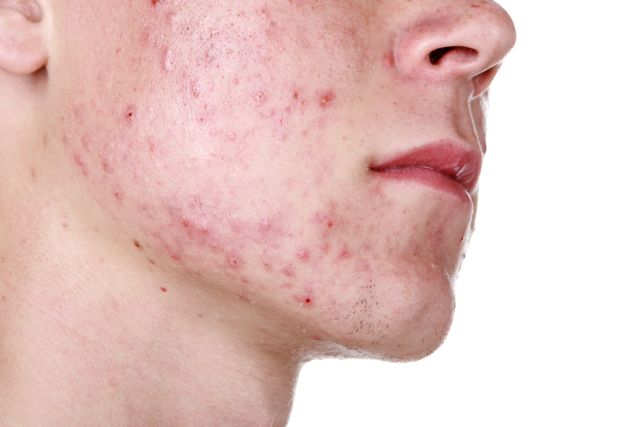
What is acne?
Acne disinformation is everywhere. Whether it’s myths about the causes or misunderstandings about who gets it, we could all do with a lesson in acne. We’ve all had a breakout of spots, so how come we can’t explain what it is? Well, we’re here to help clear things up. To put the record straight about what acne is, the different types, and how it is caused - here’s our guide to acne.
What does acne actually mean?
Acne is the name for a very common skin condition that can cause spots and irritated skin. Spots can show up anywhere on the body but most commonly affects people’s faces, backs and chests.
It can vary in severity from a few blackheads and pimples every now and again, which can be self-treated, to more severe inflammatory cysts and nodules which need medical attention.
Who does acne affect?
Acne affects most people at some point in their lives. According to the NHS, 95% of 11-30 year-olds have been affected. While it most commonly starts in your teens, it can be experienced well beyond that*.
In the teenage years, acne more commonly affect males. However in later life, this flips, and adult acne more often affects women. There is no set age when you should ‘grow out of acne’, though it does often settle down in your late teens and early 20s.
What is acne vulgaris?
Acne vulgaris is the most common form of acne and the one you think of when anyone says they have ‘acne’. At its most mild, it means you might get outbreaks of spots such as blackheads or whiteheads which show on the skin and can pop. More serious forms of acne, however, may mean deeper ‘lesions’ under the skin that can be painful and cause scarring if left untreated.
What causes acne?
Acne is caused by a combination of factors, but bacteria are the primary cause. The group of bacteria that cause acne (Cutibacterium acnes or C. acnes) are already present on the skin. They are part of what’s called your normal flora or ‘microbiome’. C. acnes likes to live in the oilier areas of the skin and in the oil ducts and hair follicles. The microbiome has been found to be slightly different in people with acne, including a loss of balance between the different types of C. acnes.
There are tiny openings in the skin, known as pores or hair follicles, which can become blocked by excess oil (sebum) and dead skin cells. Excess oil and increased skin cell shedding are common in people with acne. The blocked pores are known as comedones or as most of us know (and definitely don’t love) them: blackheads and whiteheads! The excess oil favours the growth of C.acnes bacteria.
The C. acnes bacteria thrives and multiplies in the oily blocked pores of the hair follicles. The bacteria can trigger an inflammatory response in the area, aka the redness, and sometimes painful spots!
Different types of acne
While acne vulgaris is the most common type of acne, you may come across other terms that describe the different types of acne and the spots or ‘lesions’ they produce. Some of those include:

Comedonal acne:
These small, white or flesh-coloured bumps form under the skin and are common for people with acne. They are caused by blocked hair follicles and are most common on the forehead and chin.
Cystic acne:
A more serious form of acne, it is characterised by large cysts that form underneath the skin. This type of acne leaves people most at risk of scarring if cysts burst.
Fungal acne:
This type of acne, most common in teenagers, is caused when there is essentially a yeast infection in your hair follicles. This happens when your body produces too much oil, which clogs your pores and mixes with bacteria and yeast present on your skin to irritate your hair follicles.
Hormonal acne:
This term is often used to describe acne that affects people between 20 and 50. Most commonly affecting pregnant women, excess oil production is triggered by hormonal changes such as during pregnancy, during menopause, or when changing birth control. Skin can also be affected by the hormone fluctuations during menstrual cycles.
Acne rosacea:
Also known simply as Rosacea, this long-term skin condition can cause redness and skin irritation as well as spots and pimples.
Nodular acne:
A less severe form of acne than cystic, people with nodular acne also have red bumps under the skin that can be painful to the touch. It can also cause scarring if left untreated.
Baby acne:
Does what it says on the tin! Affecting newborns, spots or pimples can show up on the skin just after birth and typically fade within a few days.
Acne mechanica:
Caused by friction, most commonly during exercise, pimples may appear where your body rubs against clothing or other pieces of your body, such as your inner thigh.
How to treat acne
Acne can be treated in a number of ways depending on the severity of your symptoms. For mild acne, you may decide to use treatments bought online or in store. The Benzoyl Peroxide (BPO) in Acnecide is an active ingredient that is applied topically (i.e. to the skin surface). It helps fight spots by killing up to 95% of the bacteria that causes acne. BPO dries up oiliness and deeply exfoliates dead skin cells to help unclog and reduce blocked pores.
Benzoyl peroxide is indicated for treating acne vulgaris, which would include comedonal acne and hormonal acne. It is not necessarily suitable for treating all types of acne. For example; baby acne, acne rosacea, acne mechanica or fungal acne, have different causes from acne vulgaris, which need to be addressed in an appropriate treatment plan. In other cases the skin sensitivity type or age of the person are not compatible.
For more serious cases of acne, you may decide to consult a doctor or healthcare professional like a pharmacist. As well as prescribing topical treatment, they may also recommend that you start a daily skincare routine to help improve overall skin health.
*1. NHS website [Last Accessed 13.2.23] https://www.nhs.uk/conditions/acne/

